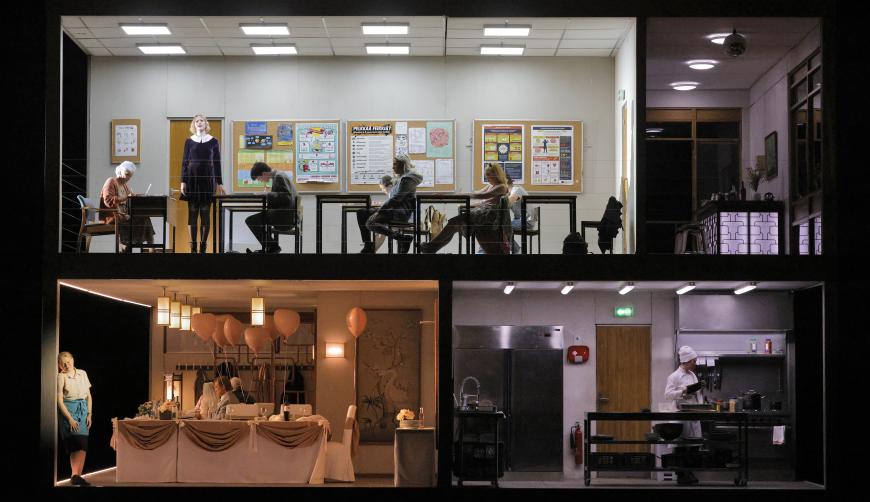
Memory plays an important role in the works of the late Finnish composer Kaija Saariaho, who died a year ago at only 70. For example, of her second string quartet, Terra Memoria, dedicated to the “departed,” she wrote: “Those of us who are left behind are constantly reminded of our experiences together. … Even after many years, some of these memories change, some remain clear flashes which we can relive.”
The relationship between past and present structures Saariaho’s last opera, Innocence, which had its U.S. premiere at San Francisco Opera, one of the commissioning organizations, on Saturday, June 1. Innocence is a masterpiece and a triumph for all involved, a magnificent, harrowing, and complex opera with harshly beautiful music and a nuanced libretto by Sofi Oksanen.
A brilliant production by Simon Stone, here staged by revival director Louise Bakker, and a superb ensemble cast bring Innocence vividly to life. Conductor Clément Mao-Takacs, who worked with Saariaho throughout the opera’s genesis and knows the music as well as anyone who isn’t the composer could, led this difficult score authoritatively and sensitively, laying out with utter clarity its musical and dramatic structures.
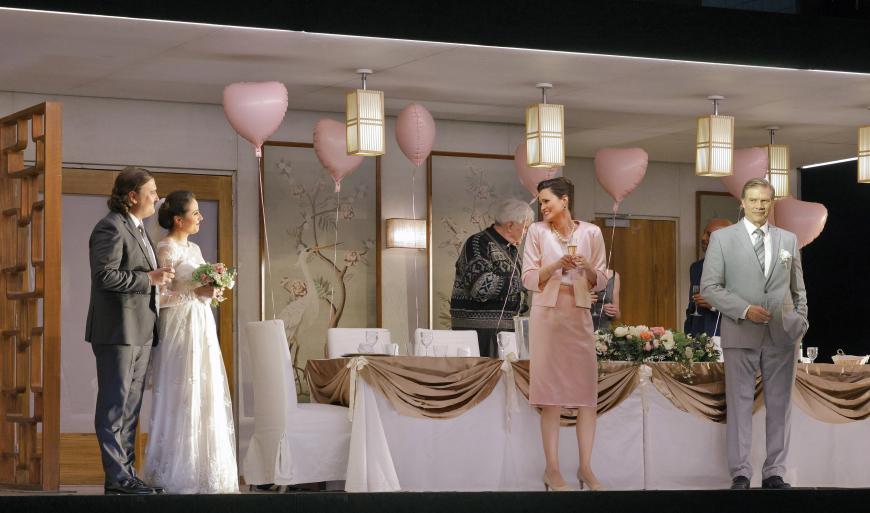
Innocence takes place at two different times, at a wedding celebration in the present and 10 years in the past during what’s initially referred to as “the tragedy.” The first words spoken, before you see the celebration, are by those who lived through the tragedy.
As they speak, you come to understand that these are students and a teacher who survived a mass shooting at an international school in Helsinki. You also come to understand that the groom’s brother was the killer, that the bride is unaware of this, and that the waitress at the wedding is the mother of one of the dead students.
The action of the opera takes place on designer Chloe Lamford’s two-level revolving set, which represents both the school and the venue where the wedding takes place. As it revolves, the scenery mysteriously evolves to reflect the stage action. The wedding scenes are largely on the lower level; the school scenes are set on both levels. The multiple complex set changes take place seamlessly, almost magically, accomplished by 29 unseen members of the stage crew — who fittingly get the first bow when the opera concludes. The SF Opera Chorus, also unseen, narrates some of the action and provides a voice for some of the characters. Sometimes the chorus sings in full voice, and sometimes you hear it almost subliminally, as if at a great distance. The chorus is glorious and gets the second bow.
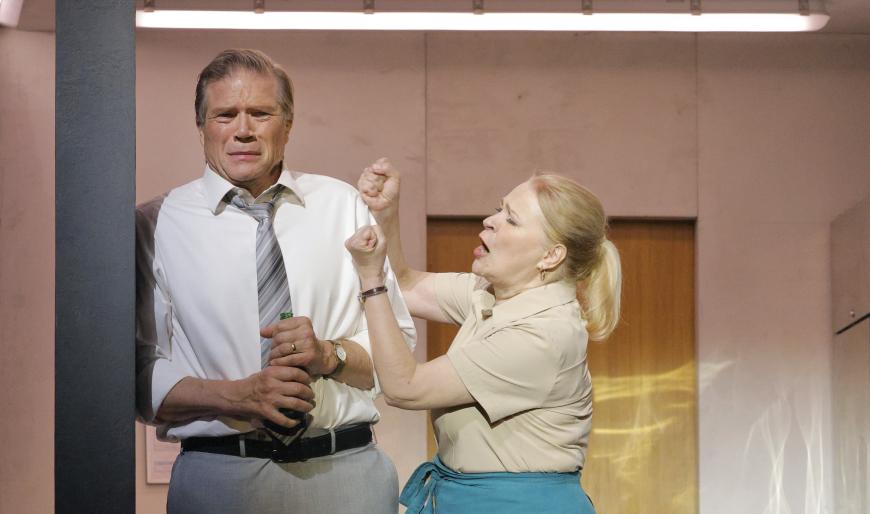
Most of the characters are double-named with a role and a given name. Mezzo-soprano Ruxandra Donose sings gloriously as Tereza, the Waitress, still haunted by the death of her daughter a decade before. Stela, the Bride, gorgeously sung by the Dutch soprano Lilian Farahani, has come to Finland to marry Tuomas, the Groom. They love each other very much, but the Groom, the impassioned tenor Miles Mykkanen, is haunted by his brother’s actions.
Baritone Rod Gilfry is Henrik, the troubled Father-in-Law, whose family is falling apart around him. Patricia, the Mother-in-Law, sung by the lovely coloratura soprano Claire de Sévigné, appears wholly divorced from reality. The Priest, sung with kind heartiness by bass Kristinn Sigmundsson, does not have a name. Julie Hega’s Iris is as chilling a character as I have ever seen in opera. The shooter is never named, and though the libretto specifies that he should not appear onstage, he is briefly seen in this production.
Innocence unfolds like a puzzle, each revolution of the set revealing new details of the shooting and its effects on the survivors. Oksanen constructed her elegant libretto such that you don’t know the full story until the last few scenes of the opera, and as complex as the action is, the libretto and production make it perfectly clear. Oksanen wrote the original libretto in Finnish, and dramaturg Aleksi Barrière adapted it into English, Finnish, Czech, Romanian, French, Swedish, German, Spanish, and Greek, befitting an opera that takes place at an international school.
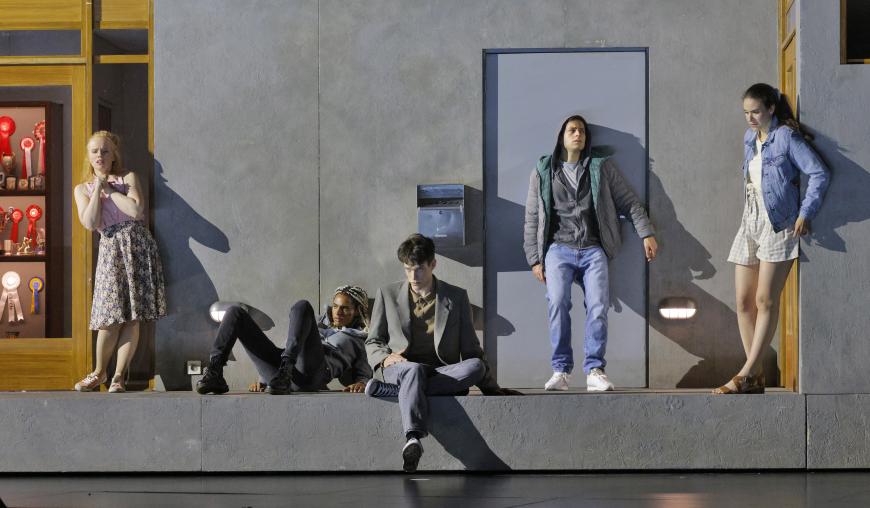
The program book provides both a brief synopsis and a separate full synopsis, noting that the full synopsis contains spoilers. This reviewer suggests that if you attend, you do not read the full synopsis until after the opera concludes.
Innocence deals with responsibility, guilt, and — most profoundly — trauma. Who didn’t recognize that the shooter was troubled? Who taught him to shoot? Who mistreated him and how? Who is in denial? Who knows the whole of what happened? A survivor can’t have his back to the door. In the present, Tereza buys her daughter’s favorite apples, then throws one away as if Markéta had eaten it. The Father-in-Law has a drinking problem. The Priest has lost his faith.
As the opera progresses, the characters at the wedding come into open conflict with each other. Details undreamt of emerge, and you learn of the damage done by secrets old and new. The trauma is ongoing for everyone near the tragedy, whether they were at the school or not.
Saariaho’s music for this profoundly disturbing work is itself disturbing. The opera opens with deep rumblings in the orchestra, rising to a tremendous volume as the curtain goes up. Unsettled harmonies constantly shift. A large percussion section and extended techniques throughout the orchestra provide a huge range of colors, with the winds and percussion coming to the fore more often than the strings. The vocal writing is largely conversational, with some of the text spoken or screamed or whispered. Several characters do have brief and distinctive aria-like passages.
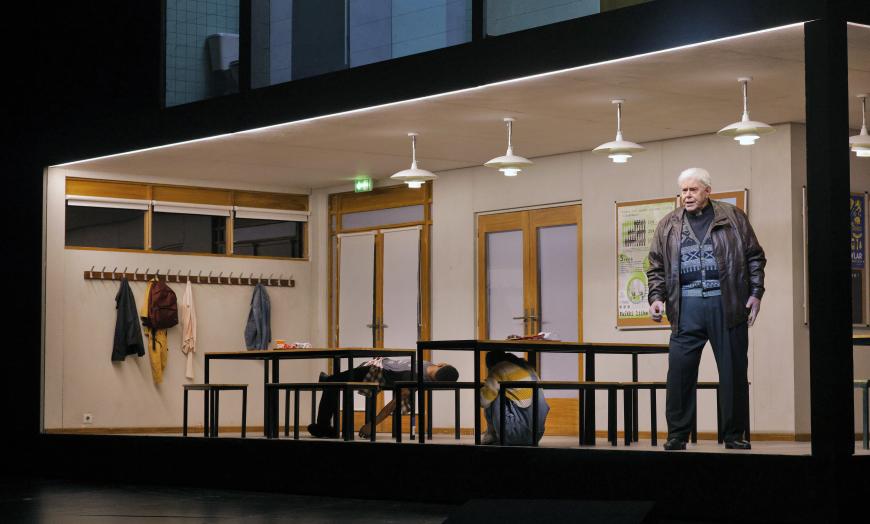
Saariaho layers the music such that you can hardly take it all in with a single hearing, yet the layers are all audible. Themes emerge and sometimes recur. The singers, including those in the chorus, are all amplified, and their voices are easy to hear whether they’re speaking or singing, owing to the excellence of Timo Kurkikangas’s sound design and engineering.
The composer also styled each character’s music with great specificity and in some cases for specific singers. For the extraordinary Vilma Jää, a researcher and folk singer specializing in Finno-Ugric singing and herding songs, Saariaho composed music high in Jää’s range, decorated with yips and cow-calling techniques. The vocal line for soprano Lucy Shelton, the Teacher, moves slowly, dragging out the words as if they’re being pulled from deep within her body. And the Teacher sometimes literally drags herself around the set.
Is healing possible for anyone under these terrible circumstances? In the closing minutes of Innocence, the music lightens, and the libretto provides a flicker of hope as you hear of how the survivors’ lives have progressed since the shooting. Is any such thing possible? Is healing possible in the United States, a country where mass shootings are a near-daily occurrence and it seems impossible to take effective action against them?
SF Opera’s production of Innocence plays through June 21, with the June 12 performance available for livestream viewing.




